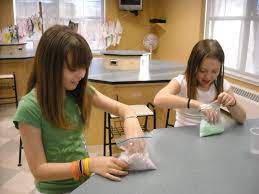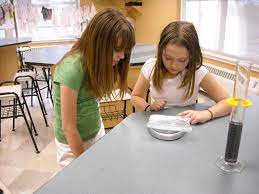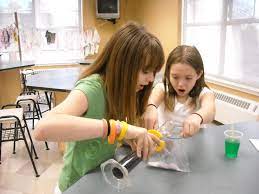I created a lab using the Instant Snow Polymer (Sodium Polyacrylate) from Educational Innovations that I use in my 8th grade Physical Science Class as well as Summer School Programs that I teach for grades 4-9. This lesson incorporates concepts of Conservation of Mass, Properties of Matter, Metric Measurement and Conversion, and Observation Skills. The lab, as I give it to the students, is listed below.
Each student receives an empty baggie to be used for comparison, a baggie containing 12 grams of Instant Snow Polymer, use of a balance and a graduated cylinder.
I have already explained the Law of Conservation of Mass, and Density (they need to remember that the density of water is 1 g/ml, or look it up) prior to introducing this lab activity. However, they do not know the terms exothermic, endothermic, hydrophobic or hydrophilic. My students are allowed to look them up, but unless they make careful observations as they are conducting the experiment, they won’t be able to answer the questions later.
The final question “What is That Stuff?” garners some interesting answers. Some recognize a use for it as snow for ski slopes; others have suggested material for ice packs. One suggestion was to use the powder to help clean up and absorb spills.
It is wonderful to see the faces of the students as they are in awe of what is occurring in the baggie. I allow the students to color the water, if they so desire. One year I did the lab on Saint Patrick’s Day. Guess what color most students chose?
Elaine Kotler Saint Paul School, Kensington, CT Summer Options for Kids, West Hartford, CT Kids on Campus, Middlesex Community College, Middletown, CTInstant Snow Polymer Lab
What Is That Stuff?
1. Record mass of the empty baggie as given by Miss K (A)
2. Without opening the baggie, use a scale to measure the mass of the bag with the contents in grams (B). Record data.
3. Calculate the mass of original contents by subtracting the mass of the empty baggie from the mass of the baggie with the original contents. Record data (C).
4. Feel the contents of the baggie through the baggie and think about how it feels temperature–wise.
5. Using a graduated cylinder, measure 160 ml of water. Record volume of water (D).
6. Calculate the mass of the water. DO NOT MEASURE!! Record data (E)
7. Open baggie and add water to the powder.
8. Immediately zip the bag closed.
9. Shake the bag to mix the powder and water and watch what happens. DO NOT OPEN THE BAGGIE.
10. Without opening the baggie, take the mass of the baggie and its contents (F). Record data.
11. Calculate the mass of new contents by subtracting the mass of the baggie from the mass of the baggie and the new contents. Record data (G).
12. Feel the contents of the baggie through the baggie and think about how it feels temperature–wise. Make careful observations.
 13. Add your measured mass for the original contents (C) and the calculated mass of the water (E). Record data (H).
13. Add your measured mass for the original contents (C) and the calculated mass of the water (E). Record data (H).
14. You may now open the bag and play with the material. It is non-toxic, however DO NOT PUT IN MOUTH.
15. Clean up.
16. Answer the attached questions.
Student Sheet
You must look up any terms you are unfamiliar with that are used in this handout.
Measurements and Calculations 10 points
A = mass of baggie (g) ____
B = mass of baggie and original contents (g) ____
C= mass of original contents (g) B – A ____
D = volume of water (ml) ____
E = mass of water (g) ____
F = mass of baggie and new contents (g) ____
G = mass of new contents (g) F – A ____
H = C + E (g) ____
What Is That Stuff?
Questions
1. Explain why you needed to measure the mass of the baggie during the experiment. (15)
2. Explain how you arrived at your answer for E, since the mass of the water was not measured. (15)
3. Is your answer to G the same as your answer to H (± 3 g for margin of error)? Explain why or why not. (15)
4. Is this reaction exothermic or endothermic? Explain. (15)
5. Is the powder hydrophilic or hydrophobic? Explain. (15)
6. And, finally, what is that stuff? Describe it, give it a name and describe one use for that stuff. (15)
NAME _________________ Score ________ out of 100



I played with this stuff the other day at a science conference. When water is added initially you feel warmth then once the polymer expands in volume you feel the coolness. I was told there are both exo- and endothermic reactions therefore. Your students presumably do not notice this?
Also, can you post the answers to your 6 (or 5) questions? Or send them to me?
Thank you.
Hi John,
The easiest way to demonstrate the exo- and endothermic reactions is to hydrate a small amount in the hands of your students. As the water is added, they will clearly feel the heat. If they touch the already expanded snow that has been sitting around for more than about 15 minutes, they will feel that it is cool to the touch indicating that evaporation is endothermic. Teachers and students (of all ages), love “playing” with the snow polymer!
I find your lab experiment really interesting and amusing a combination difficult to make.
I’ll try this with my students I’m sure they’ll love it